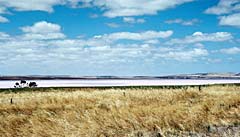
Meeting kangaroos, cockatoos, emus and seals (sequel)
Flinders Range - Adelaide - Kangaroo Island with the Flinders Chase park
Click on a picture to enlarge. These pages show only a small selection of the 400 pictures of Australia. Order the CD to view all pictures full screen (800 x 600 pixels) and to enjoy the slide shows with original music! The CD offers you also the complete interactive story, suitable for quick viewing and printing.
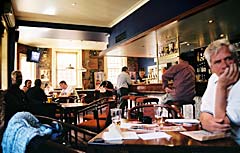 On
our way to Adelaide we pass an absolutely pink lake. I’ve read about the phenomenon
but couldn’t believe it. However, the lake really is pink. The effect is caused
by a combination of the salt degree and the temperature. Extremely strange!
On
our way to Adelaide we pass an absolutely pink lake. I’ve read about the phenomenon
but couldn’t believe it. However, the lake really is pink. The effect is caused
by a combination of the salt degree and the temperature. Extremely strange!
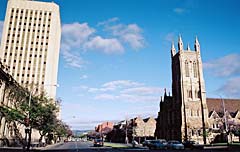 Adelaide
is full, busy and not so interesting. We find it very dirty and noisy after
three weeks camping in West Australia. From our Lonely Planet we choose a cheap
hotel, which luckily still has vacancies until
Adelaide
is full, busy and not so interesting. We find it very dirty and noisy after
three weeks camping in West Australia. From our Lonely Planet we choose a cheap
hotel, which luckily still has vacancies until the ‘Adelaide Golf Open’ a couple of days later will start. We get a small room
on the second floor with a spacious verandah looking out over the street and
right into the police station at the opposite site so we don’t have to be bored.
the ‘Adelaide Golf Open’ a couple of days later will start. We get a small room
on the second floor with a spacious verandah looking out over the street and
right into the police station at the opposite site so we don’t have to be bored.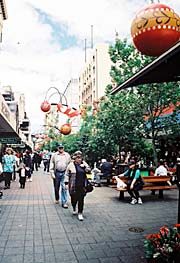 We chat with the owner of the hotel and his wife, we do our washing and we return
our rental car and hire a new one for a very low price. A couple of days later
we will pick up the new car, first we want to visit Kangaroo Island. Very much
to our relief the woman who inspects our car says, even after our guilty complains
of hailstorms, nothing about the bumps (when the light is right and the car
is a bit wet you don’t see the bumps so much) so we get our 1000 AUD back! A
great relief and now we have enough money to celebrate Jacs’ birthday properly
with a very nice diner!
We chat with the owner of the hotel and his wife, we do our washing and we return
our rental car and hire a new one for a very low price. A couple of days later
we will pick up the new car, first we want to visit Kangaroo Island. Very much
to our relief the woman who inspects our car says, even after our guilty complains
of hailstorms, nothing about the bumps (when the light is right and the car
is a bit wet you don’t see the bumps so much) so we get our 1000 AUD back! A
great relief and now we have enough money to celebrate Jacs’ birthday properly
with a very nice diner!
Kangaroo Island is surely one of the most beautiful places
we visited in Australia. The island is fairly  empty
and the big Flinders Chase Park on the west side of the island is incredible
beautiful. We visit ‘Seal Bay’, an Australian sea lion colony where you can
watch and photograph the sea lions from only a few meters distance. I’ve always
liked seals, no idea why, must be their cuddlesome round forms and their adorable
black eyes! Our bus driver
empty
and the big Flinders Chase Park on the west side of the island is incredible
beautiful. We visit ‘Seal Bay’, an Australian sea lion colony where you can
watch and photograph the sea lions from only a few meters distance. I’ve always
liked seals, no idea why, must be their cuddlesome round forms and their adorable
black eyes! Our bus driver 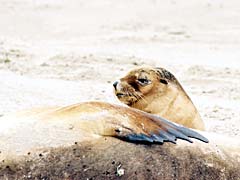 annex
guide warns us to take a spare roll of films and indeed, I almost spend two
films - intended for the total visit to Kangaroo Island - on these sea lions.
Now I have only part of a film left for the remarkable rocks, which are even
more remarkable than I already feared, and for Cape du Couedic and Admiral Arch
with extremely beautiful views of wild seas, high rocks, dramatic sunlight and
again: seals! Not fair, so many incredible beautiful places in one park!
annex
guide warns us to take a spare roll of films and indeed, I almost spend two
films - intended for the total visit to Kangaroo Island - on these sea lions.
Now I have only part of a film left for the remarkable rocks, which are even
more remarkable than I already feared, and for Cape du Couedic and Admiral Arch
with extremely beautiful views of wild seas, high rocks, dramatic sunlight and
again: seals! Not fair, so many incredible beautiful places in one park!
After this our chauffeur stops at a place in the forest where
we can watch Koala’s. We see a Koala 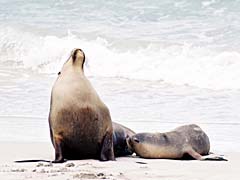 sleeping
high in a tree (picture), some more with young somewhat lower in trees (more
pictures) and even an active one walking around and eating leafs (more more
pictures and that was the end of my supply). The chauffeur explains Koala’s
are a bit of a problem on Kangaroo Island. They have no enemies here and also
no problems
sleeping
high in a tree (picture), some more with young somewhat lower in trees (more
pictures) and even an active one walking around and eating leafs (more more
pictures and that was the end of my supply). The chauffeur explains Koala’s
are a bit of a problem on Kangaroo Island. They have no enemies here and also
no problems with illness, which both are the main reasons the Koala’s are scarce on the
mainland. Their favorite brands of eucalyptus trees are still abundantly available,
that is, when the number of Koala’s doesn’t continue to explode. The chauffeur
says they don’t know what to do with them, what about the image of Australia
in the world, which is already not very good with all the problems with Aboriginals
and the policy against refugees and will certainly not improve with Australians
shooting Koala’s. So some are transported and most where castrated, a practice
which obviously escapes the attention of the world till now (and which the Australian
government would happily extend to Aboriginals and refugees if sure it would
escape the worlds’ notice also).
with illness, which both are the main reasons the Koala’s are scarce on the
mainland. Their favorite brands of eucalyptus trees are still abundantly available,
that is, when the number of Koala’s doesn’t continue to explode. The chauffeur
says they don’t know what to do with them, what about the image of Australia
in the world, which is already not very good with all the problems with Aboriginals
and the policy against refugees and will certainly not improve with Australians
shooting Koala’s. So some are transported and most where castrated, a practice
which obviously escapes the attention of the world till now (and which the Australian
government would happily extend to Aboriginals and refugees if sure it would
escape the worlds’ notice also).
At night we see some fairy penguins at ‘Penguin Beach’ in Kingscote,
the small center town of Kangaroo Island. Fairy or little penguins are only
to be found in Australia and New  Zealand.
The adults are about 30 centimeters high. We expected something bigger and when
our guide shows us the hole where some penguins hide I have difficulty believing
him… At this time of the year you can’t see many penguins because they are molting.
This period starts with overeating (Jac and I must be starting our molting quite
soon) and once they molt they can’t enter the sea for three weeks because their
pack of feathers isn’t waterproof. Anyway we see a couple of penguins and even
young ones hiding in between stones, flapping their tiny wings as if cold (which
we understand because the wind is freezing). Early in the
Zealand.
The adults are about 30 centimeters high. We expected something bigger and when
our guide shows us the hole where some penguins hide I have difficulty believing
him… At this time of the year you can’t see many penguins because they are molting.
This period starts with overeating (Jac and I must be starting our molting quite
soon) and once they molt they can’t enter the sea for three weeks because their
pack of feathers isn’t waterproof. Anyway we see a couple of penguins and even
young ones hiding in between stones, flapping their tiny wings as if cold (which
we understand because the wind is freezing). Early in the  morning
we look for the penguins but they went fishing or hide in between the rocks.
In stead of penguins we see a lot of black swans, dozing away on the beach,
balancing on one leg, head hidden in their feathers, the long neck intricately
bend. Above us we see a flock of at least 20 pelicans, formation flying with
slow, majestically beats of their wings in the strong wind. Kingscote is a very
quiet place and if you are afraid to collapse due to an overdose of stress,
just go and live over here in one of the old cottages with a verandah complete
with comfortable chairs overlooking the sea. Stay here for at least three months.
Results guaranteed.
morning
we look for the penguins but they went fishing or hide in between the rocks.
In stead of penguins we see a lot of black swans, dozing away on the beach,
balancing on one leg, head hidden in their feathers, the long neck intricately
bend. Above us we see a flock of at least 20 pelicans, formation flying with
slow, majestically beats of their wings in the strong wind. Kingscote is a very
quiet place and if you are afraid to collapse due to an overdose of stress,
just go and live over here in one of the old cottages with a verandah complete
with comfortable chairs overlooking the sea. Stay here for at least three months.
Results guaranteed.
In the afternoon we stopover at a ranch were eucalyptus oil
is made in a very environmental friendly 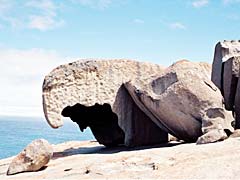 way
(or so they took a lot of trouble to explain). You will be happy to know that
you can use eucalyptus oil for and against almost everything. After the ranch
we visit a honey farm, a sheep dairy and a Wildlife Park with native animals
which we have all seen ‘in the wild’ already - I wonder why they keep them imprisoned
over here when you can see them everywhere walking around free. Our guide is
inspired today and explains the enormous impact on Australian life of the characteristics
of the
way
(or so they took a lot of trouble to explain). You will be happy to know that
you can use eucalyptus oil for and against almost everything. After the ranch
we visit a honey farm, a sheep dairy and a Wildlife Park with native animals
which we have all seen ‘in the wild’ already - I wonder why they keep them imprisoned
over here when you can see them everywhere walking around free. Our guide is
inspired today and explains the enormous impact on Australian life of the characteristics
of the 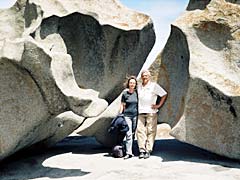 Australian
soil. This soil has deficiencies of spore elements. Doesn’t sound so bad, but
as a result cultivated crops like grains can’t survive. The same goes for cattle.
Early settlers over here and also in Wilpena Pound, the Flinders Range paradise,
transported a lot of sheep and cows to Australia. The first half year everything
went right, but then animals started to die. Nobody understood what was going
on and it took till the beginning of the 20th century till science solved the
problem. Only a tiny addition of the missing spore elements to the soil was
sufficient to grow grains and raise cattle.
Australian
soil. This soil has deficiencies of spore elements. Doesn’t sound so bad, but
as a result cultivated crops like grains can’t survive. The same goes for cattle.
Early settlers over here and also in Wilpena Pound, the Flinders Range paradise,
transported a lot of sheep and cows to Australia. The first half year everything
went right, but then animals started to die. Nobody understood what was going
on and it took till the beginning of the 20th century till science solved the
problem. Only a tiny addition of the missing spore elements to the soil was
sufficient to grow grains and raise cattle.
Our bus driver clarifies that since it was impossible
in the old days for the aboriginals to cultivate crops 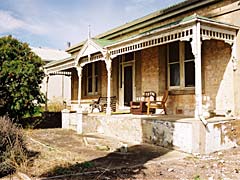 or
raise cattle they were forced to hunt and search for food, a way of life which
makes it impossible to settle on one place. When you are permanently traveling
around it is not worth wile to invest much energy in things that have to stay
on a certain place or are to heavy to take with you. So this way of life has
an enormous impact on the development of the culture of the aboriginals, who
where forced to ‘travel light’, which can be a disadvantage but surely has also
many advantages.
or
raise cattle they were forced to hunt and search for food, a way of life which
makes it impossible to settle on one place. When you are permanently traveling
around it is not worth wile to invest much energy in things that have to stay
on a certain place or are to heavy to take with you. So this way of life has
an enormous impact on the development of the culture of the aboriginals, who
where forced to ‘travel light’, which can be a disadvantage but surely has also
many advantages. 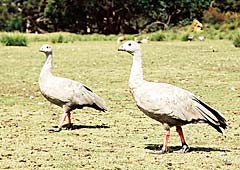 But
with their non-competing culture of doing things as a group and surviving well-balanced
with nature, the aboriginals couldn’t imagine the European mentality of using
and destroying the nature and were totally unprepared for dealing with the European
early settlers. So were the seals, our driver goes on. It took the Europeans
only 20 years to all but destroy the abundant seal colonies on Kangaroo Island.
The animals didn’t have any experience with enemies and were very easy to kill.
Luckily by now the population has grown again a bit but the seals didn’t learn
much, they are still very trusting and unafraid. For the Aboriginals it seems
to me almost impossible – even in this big land with enormous space - for them
to follow their own tradition and live in harmony with the nature. The contradictions
with the western way of life are simply to big. And alas for us, we are to far
gone to go back.
But
with their non-competing culture of doing things as a group and surviving well-balanced
with nature, the aboriginals couldn’t imagine the European mentality of using
and destroying the nature and were totally unprepared for dealing with the European
early settlers. So were the seals, our driver goes on. It took the Europeans
only 20 years to all but destroy the abundant seal colonies on Kangaroo Island.
The animals didn’t have any experience with enemies and were very easy to kill.
Luckily by now the population has grown again a bit but the seals didn’t learn
much, they are still very trusting and unafraid. For the Aboriginals it seems
to me almost impossible – even in this big land with enormous space - for them
to follow their own tradition and live in harmony with the nature. The contradictions
with the western way of life are simply to big. And alas for us, we are to far
gone to go back.
Back to Virtual Traveling home